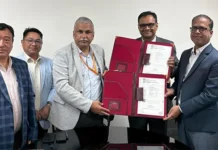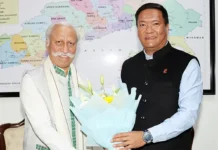ITANAGAR, 17 Oct: The second joint scientific expedition to Khangri Glacier in Tawang district was flagged off by Chief Secretary Manish Kumar Gupta on Monday, in the presence of the Science & Technology Secretary Sumedha, Centre for Earth Sciences & Himalayan Studies (CES&HS) Director Tanna Tage, and others, from the civil secretariat here.
The expedition team consists of a group of scientists, research associates, and technical officers from the National Centre for Polar & Ocean Research (NCPOR), Goa, the CES&HS, Itanagar, and research scholars from IIT Roorkee (IITR). This collaborative effort is part of an ongoing initiative to conduct in-depth glaciological and cryosphere studies in the Arunachal Himalayas.
The research team will conduct several key scientific activities, including measuring glacier flow discharge, riverbed profiling, steam ice drilling and installation of water level markers and stacks for long-term observation. They will also engage in mass balance studies, which are crucial for understanding the gain and loss of ice mass from the glacier system. The team will also identify a suitable location to establish a permanent base camp as part of the Polar and Cryosphere Studies (PACER), which will serve as a logistical hub for future glaciological studies in the region, with focus on the Khangri Glacier and other glaciers in Arunachal.
The event saw the participation of several key team members, including Dr Sandeep Kumar Mondal, Dr Anupam Gokhale, Dr Karthik CB, engineers N Sunmukh Rao, Dipak, Romik Tato and Sange Tsering, besides Tapas Kumar Nahak and Sanjay Kumar Dwivedi from the NCPOR, the CES&HS, and the IITR, respectively.
The team briefed the chief secretary on the field activities, which will include installation of an automatic weather station with satellite communication, automatic water level recorder, conducting hydrological investigations, installing stakes, and collecting snow and sediment samples for lab analysis. They will also perform steam ice drilling for mass balance measurement and gather other critical data during the fieldwork.
“The Arunachal Himalayas are ecologically sensitive and face significant challenges related to climate change, including glacial melting, changes in freshwater availability, and the risk of glacial lake outburst floods (GLOF),” Tage said, and added that understanding these dynamics are crucial for ensuring the sustainability of the local ecosystems, economies, and the communities dwelling in high altitudes.






